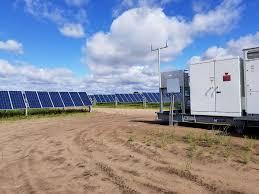Smart Inverters and the Future of Renewable Energy Systems

Introduction
The Renewable Energy Inverters Market is growing rapidly as global energy systems transition toward clean power generation through solar, wind, and hybrid renewable sources. Renewable energy inverters convert variable DC output from solar panels, wind turbines, or storage systems into AC power compatible with grids and electrical systems. These inverters also regulate voltage, optimize power output, and ensure grid stability, making them essential for renewable energy integration. With the rise of rooftop solar systems, utility-scale solar farms, wind energy projects, and battery energy storage systems (BESS), demand for efficient and smart inverters is increasing. The market is projected to grow at a CAGR of around 8–10% over the forecast period, driven by net-zero commitments, government incentives, falling renewable system costs, and rapid grid modernization. As renewable penetration increases, advanced inverters with smart grid support, remote monitoring, and energy management capabilities are becoming crucial for future-ready energy ecosystems.
Market Drivers
Rising global investments in solar and wind installations are major drivers accelerating inverter adoption. Government subsidies, tax benefits, and renewable energy mandates are promoting large-scale and residential renewable adoption. Declining solar PV costs and increased deployment of rooftop solar systems across residential and commercial buildings further fuel inverter demand. Increasing grid instability and need for distributed power generation are boosting the use of hybrid inverters that support on-grid and off-grid applications with storage. Smart inverters with grid-forming capabilities are gaining traction as utilities require voltage, frequency regulation, and reactive power support for renewable-heavy grids. Technological advancements, including AI-based monitoring, MPPT (Maximum Power Point Tracking), and IoT-based remote diagnostics, also support market growth. Additionally, growing demand for BESS integrated with renewables is driving adoption of bidirectional and hybrid inverters.
Market Challenges
High installation and maintenance costs of advanced inverters, especially for grid-scale projects, pose adoption challenges. Inverter efficiency degradation due to heat, dust, and environmental exposure affects long-term performance, requiring robust protection and cooling systems. Grid compatibility and regulatory differences across regions create compliance complexities for manufacturers. Cybersecurity risks increase as smart and connected inverters become integrated with cloud-based monitoring and grid networks. Limited recycling and end-of-life management solutions for inverter components create sustainability challenges. Technical issues such as harmonic distortion, voltage fluctuation, and inverter clipping may impact energy quality and output. Additionally, supply chain disruptions affecting semiconductor and electronic components may impact inverter manufacturing.
Market Opportunities
Rising deployment of hybrid renewable energy systems integrating solar, wind, and battery storage offers strong opportunities for hybrid and bidirectional inverters. Development of grid-forming and microgrid-ready inverters presents growth prospects for remote, off-grid, and disaster-resilient energy systems. Emerging markets in Africa, Latin America, and Southeast Asia offer long-term opportunities for rural electrification using solar inverters. Growth of EV charging infrastructure powered by renewables presents new applications for smart inverters with load balancing. AI and IoT-enabled inverters for predictive maintenance, performance optimization, and energy forecasting create new value propositions. The rise of virtual power plants (VPPs) and peer-to-peer renewable trading models offers scope for advanced inverter integration. Hydrogen-based renewable projects may incorporate power conversion solutions, opening new revenue streams.
Regional Insights
Asia-Pacific dominates the Renewable Energy Inverters Market due to large solar and wind capacity additions and aggressive renewable targets across China, India, Japan, South Korea, and Australia. China leads with massive solar manufacturing capacity and utility-scale renewable expansion. Europe holds a significant market share driven by net-zero commitments, advanced incentives, and smart grid development across Germany, Spain, Italy, and the UK. North America shows strong growth with increasing solar rooftop adoption, community solar projects, and wind power deployment in the U.S. and Canada. The Middle East is emerging rapidly with large-scale solar projects in the UAE, Saudi Arabia, and Qatar. Latin America and Africa present future growth opportunities with expanding renewable access programs and rural electrification projects.
Future Outlook
The future of the Renewable Energy Inverters Market will be shaped by smart grid integration, hybridization, and digital energy ecosystems. Next-generation inverters will shift from simple power conversion devices to intelligent energy management hubs integrated with AI, storage, and grid communication. Grid-forming inverters will gain prominence to maintain grid stability in high-renewable systems. Bidirectional inverters supporting EV charging and V2G (Vehicle-to-Grid) applications will grow with e-mobility expansion. Ultra-high-efficiency silicon carbide (SiC) and gallium nitride (GaN) inverters will dominate due to performance and thermal benefits. Sustainable and modular inverter designs with longer lifespans and recyclability will align with circular economy goals. As clean energy becomes central to global power generation, renewable inverters will play a critical role in shaping the future of smart, flexible, and resilient energy systems.
Conclusion
The Renewable Energy Inverters Market is evolving rapidly as the world accelerates the shift toward clean, distributed, and sustainable energy. Inverters are essential for efficient renewable integration, grid stability, and smart energy management. While high costs, regulatory differences, and supply chain challenges exist, rapid technological innovation and renewable adoption are driving strong market growth. With smart inverters, hybrid systems, and digital energy platforms reshaping the energy landscape, inverter technology will remain at the core of future renewable ecosystems. The market is well positioned for long-term expansion as global energy systems transform toward decentralization, digitalization, and decarbonization.


